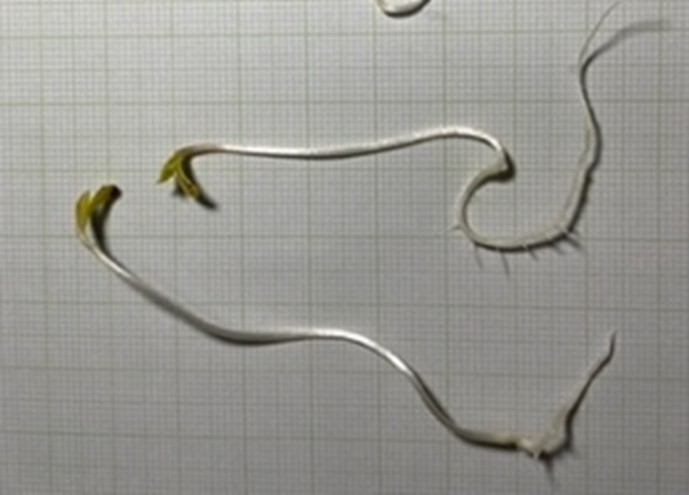Effect of Tannin Concentrate on Seed Germination of Cannabis RSU 01
Main Article Content
Abstract
The purpose of this research was to study the effect of tannin concentration on seed germination of cannabis RSU 01: the effect of tannins on the germination of cannabis seeds by using a completely randomized controlled method (CRD) consisting of 5 treatments. 3 repeats with treatment 1 using distilled water; treatments 2, 3, 4, and 5 using tannin at concentrations of 300, 600, 1,200, and 1,500 mg/l. Then all seeds were cultivated: planting between papers and watering according to the above treatments. Germination data of cannabis plants collected: germination seeds, dead seeds, normal seedlings, abnormal seedlings, shoot length, root length, leaf length, weight of fresh shoot seedling, weight of fresh seedling roots, weight of dry shoot seedling. and weight of dry seedling roots. Calculated percentage of germination, statistical analysis showed that the amount of tannin with distilled water gave the highest germination percentage and the highest normal seedling in part of Cannabis RSU 01 seeds. The amount of tannin with a tannin concentration of 300–1500 mg/L gave the lowest germination, normal seedling percentage, and increased dead seed.
Article Details
References
กรมวิทยาศาสตร์การแพทย์ กระทรวงสาธารณสุข. (2564). กรมวิทย์ฯ มทร.อีสาน และมหิดล ร่วมพัฒนากัญชาพันธุ์ไทย. เมื่อ 11 พฤศจิกายน 2566, จาก https://www.dmsc.moph.go.th/post-view/1114
ชยันต์ พิเชียรสุนทร. (2561). การวิจัยและพัฒนาสารสกัดกัญชาและกัญชงทางการแพทย์เพื่อการพัฒนาประเทศ. (รายงานการวิจัย). กรุงเทพฯ: สถาบันวิจัยและพัฒนา องค์การเภสัชกรรม.
ปาริชาติ พจนศิลป์, วิไลวรรณ ทวิศศรี,โกเมศ สัตยาวุธ, ทิพยา ไกรทอง, และหยกทิพย์ สุดารีย์. (2561). ศึกษาการสกัดสารแทนนินจากเปลือกมะพร้าวอ่อน. (รายงานการวิจัย). กรุงเทพฯ: สถาบันวิจัยพืชสวน กรมวิชาการเกษตร.
พรพิมล พิมลรัตน์, นิวุฒิ หวังชัย, สุพันธ์ณี สุวรรณภักดี, และพัชราวลัย ศรียะศักดิ์. (2560). เอกสารประกอบการอบรม สารสกัดแทนนินจากใบหูกวาง:วิธีการเตรียมอย่างง่าย และการประยุกต์ใช้ในปลาสวยงาม. ชุมพร: มหาวิทยาลัยแม่โจ้.
Chaudhuri, A., and Ray, S. (2016). Allelopathic potential of tannic acid and its equivalent phenolics extracted from aerial parts of Ampelocissus latifolia (Roxb.) Planch, IOSR Journal of Agriculture and Veterinary Science, 9(7), 90-100).
Corcoran, R.M., Geissman, T.A. and Phinney, B.O., (1972). Tannins as gibberellin antagonists, Plant Physiology. 49(3), 323-330. doi: 10.1104/pp.49.3.323.
International Seed Testing Association, (2014). International rules for seed testing. Wallisellen: N.P.
Koodkaew, I., Senaphan, C., Sengseang, N., and Suwanwong, S. (2018). Characterization of phytochemical profile and phytotoxic activity of Mimosa pigra L. Agriculture and Natural Resources, 52(2), 162-168. doi: 10.1016/j.anres.2018. 06.005.
Li, Z.H., Wang, Q., Ruan, X., Pan, D.C., and Jiang, D.A. (2010). Phenolics and plant allelopathy. Molecules, 15(12), 8933-8952. doi: 10.3390/molecules15128933.
Muscolo, A, Panuccio, M.R. Sidari, M., and Nardi, S. (2001). The ascorbate system during the early stage of germination in pinus laricio seeds treated with extracts from two different sources of humus, Seed Science and Technology, 29(1), 275-279.


